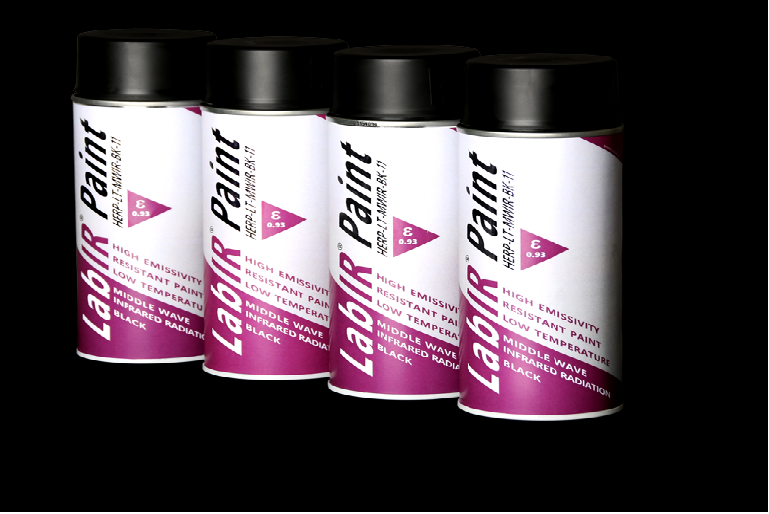What are high emissivity paints and what are they used for?
High emissivity thermographic paint enables effective temperature measurements without interaction. Many materials with a shiny exterior and elevated fluorescence (metal, glass, some plastics), with unidentified or low emissivity, give incorrect or impossible IR camera measurements. Barvy LabIR® Paints thermographic paints generate a relatively homogenous surface with high emissivity for very accurate measurements.
Emissivity of materials
Thermal radiation is emitted by all substances (at temperatures above absolute zero). For any particular temperature and wavelength, however, the overall heat radiation emitted is evaluated by the surface emissivity of the substances.
High Emissivity materials are determined as the percentage of energy radiated under the same situations from the surface of a material to energy radiated from the ideal emitter (black body emission / black body radiation).
What is emissivity and why is it important?
The emissivity of a surface not only relies on the substance and also on the surface’s existence. For instance, the emissivity of a clean and smooth surface of the metal will be low, while the emissivity of a rough surface and the oxidized metal surface will be large. As well as wavelength and angle, the emissivity also relies on the surface temp.
Awareness of surface emissivity is essential for both precise assessments of non-contact temperature and measurements of heat transfer. The thermal radiation that a surface emits is detected by radiation thermometers. Usually, they are configured using black – body reference materials with emissivity as close to 1 as there is no functional difference.
Thermographic paints offer
Thermographic paint for standard applications
Particularly, high emissivity thermographic spray paint for main techniques up to 100 °C. Clearly defined physical features and emissivity reliance on the infrared camera’s wavelength and observing angle enable accurate results of non-contact temperature evaluation.
Elementary characteristics
- High-emissivity paint
- High resistance to mechanics
- Approximately opaque
- For day-to-day use
- Appropriate for Uncooled Infrared Camera
- For temperatures up to 100 ° C
- Appropriate for use in electrical devices (very low conductivity)
Thermographic paint for high temperature
Special, thermographic spray paint with high mechanical resistance for long-term implementations at high temperatures up to 1 000 °C.
Elementary characteristics
- Paint with elevated emissivity
- High resistance to mechanics
- Opaque
- For long-term use, lasting paint
- Appropriate for Uncooled Infrared Camera
resistant to high temperatures Up to 1 000 °C - Appropriate for use in electrical devices (very low conductivity)
- Appropriate for industrial furnaces for material temperature treatment, metal parts machining, high-temperature heat-resistant building materials.
Washable thermographic paint for special applications
High emissivity washable thermographic spray paint for particular purposes at room temperature. The paint can be easily cleaned using water without the need for intimidating mechanical methods or chemical weapons. Perfect for measuring places where perpetual paint can’t be used.
Assured physical characteristics and the wavelength and camera viewing angle reliance of emissivity enable you to achieve highly accurate results of pro temperature measurements.
Elementary characteristics
- High-emissivity paint
- Water Washable
- Stable in the course of time
- Approximately opaque
- Ecological
- Compatible with room temperature
- Implementation: blades for turbines, sheet metal, glass, floors, etc.
Conclusion
In many situations of radiation thermometry, a surface emissivity measurement can be performed by means of a source paint placed on the surface to be evaluated and the radiation from the uncoated surface can be compared with the radiation from the source paint. Conversely, measurements can be taken directly from the emissions of source paint.






























